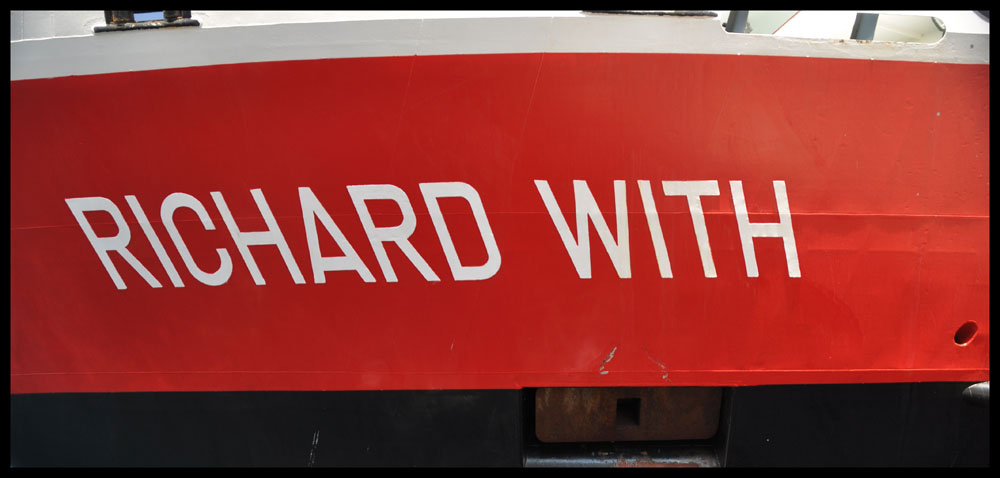
“Richard With” is the name of the founder of the company, Hurtigruten, who run the coastal ferries, the boat is named after him.
We had booked a ‘run of ship’ cabin which means we had no idea which cabin we would be allocated other than it would have a window. You pay more if you want to select a particular cabin and location.
Our cabin, 546, was on the main promenade deck so we had a ‘large’ window and easy access to go outside. Lovely. Many people walked past the window but the window is glazed so that it is hard to see into the cabin. We walked out our door and within 10 metres was the door to the deck and the outside world.





Two beds, one of which can double as a sofa, a desk, wardrobes and a dinky bathroom. All one needs for a short trip. We did ‘bed and breakfast’ on the ferry, foraged for the rest of the meals, there was a café for snacks and similar. Small gym with a view, coin operated laundry and plenty of lounges and deck space.





Exploring the coastal ferry
For those of you who are interested, here is a little about what a coastal ferry is like. I will start with food. We stayed as ‘bed and breakfast’. There is a proper dining room and a cafeteria. We had breakfast in the dining room where it was a Norwegian buffet. Plenty of the food we are used to, but in addition a lot of fish products, nuts and dried fruit, many cheeses and cold meats. Everyday there was a different product on a special table, flapjacks one day and smoked reindeer leg another !
Those who were booked as full board had a buffet lunch and a sit-down dinner. You do not dress up for dinner although you are still expected to be tidy. The cafe served a small range of meals and good soup.
The ship has a small range of facilities, a small gym with a view, a shop and a coin operated laundry. There are no theatres, no shows, no entertainment although on some voyages they do have expedition staff on board. They organise a little entertainment. For example, a lighthearted fashion show of the woollen goods for sale in the shop. Reindeer salami tasting, prawn tasting, cod filleting and drying all on the deck. There were fairly informal talk on some of the things we saw, rocks, geography, birds etc.
Some of the passengers, those travelling for less than 24hrs, do not have a cabin, so there are plenty of comfortable sitting places in different lounges.
The main entertainment is watching the ship arrive and depart at all the different ports and of course watching the scenery as one goes past. As this is a coastal voyage there is something to look at all the time. Every time another Hurtigruten ship was passed there was a lot of noise and each ship hooted their horns three times then sometimes made ‘music’ by hooting together. A ships horn is loud !
People/passengers
There are two groups of people on board, the first are the locals travelling from one town to another on the coast, the second group are tourists. The tourist choose this voyage because they want to see magnificent scenery, not to eat and be entertained. So compared to other cruise ships the passengers are very enthusiastic and rush out on deck to see what is happening. As they are enthusiastic about seeing things, they are considerate towards others who also want to watch. There is no shortage of on-deck viewing spots and normal to have people move from one side to the other as the boat does a U-turn or to look at a bridge ! When we get to port they are ready to go down the gangplank and off exploring
How a coastal ferry works
Hurtigruten run at least 12 coastal ferries. They make a 12 day trip from Bergen to Kirkeness, at the opposite end of Norway and back. One ferry leaves everyday and they stop at the same ports, once going north and once on the return trip. So each port each day will get one northbound and one southbound ferry. The ships are a vital freight and transport route for the coastal communities. Because there are so many ferries travelling up and down the coast they pass at least one ferry a day and often the northbound and south bound are berthed at the same time. As well as freight and cars there are passengers. Some like us, travellers doing a longish portion. Others are going only a few stops.
When the boat stops at a port the two gangways are lowered, they start lowering before the ship is even tied up, one is for the passengers and the other for cars and freight. Some days 6 stops were made so the staff are pretty swishy with the process. Pleasant now with the sun shining all day and night, but must be a different matter in winter.
Because they are coastal ferries they do not travel in international waters and regulations are different, but we did watch more lifeboat and man-over-board exercises than I have ever seen on a cruise ship. They took the lifeboats down into the water, detached them and did a short ride. We did have a lifeboat drill before leaving and different to cruise ships, the life jackets are all on deck and you are expected to put on a drysuit as well.
More details of the trip coming up.
Next – First day on the Richard With going north after leaving Bergen